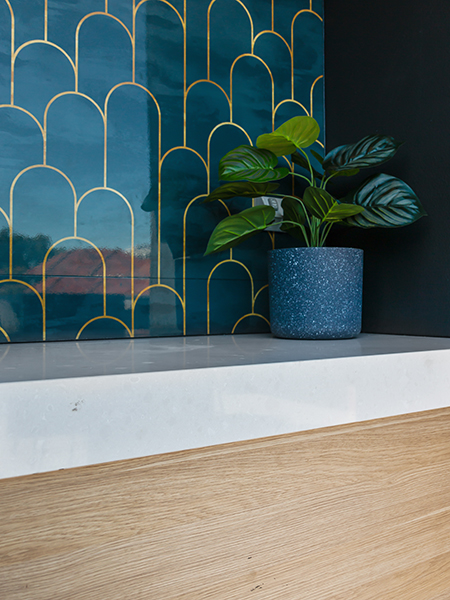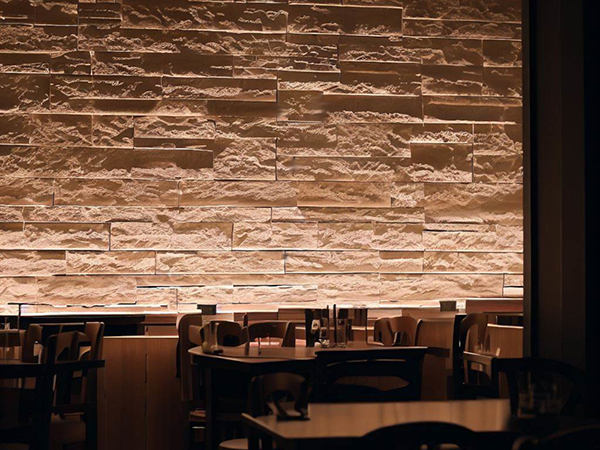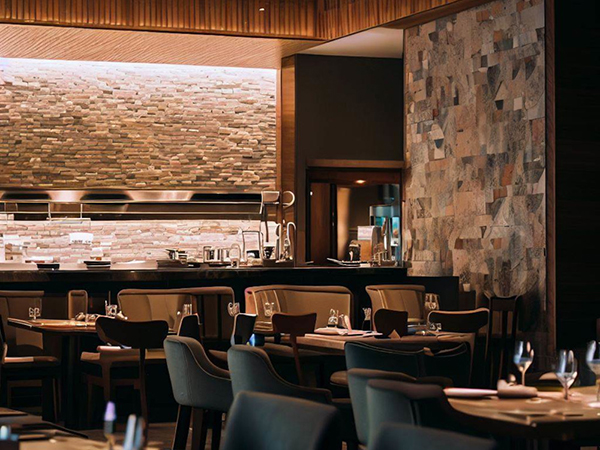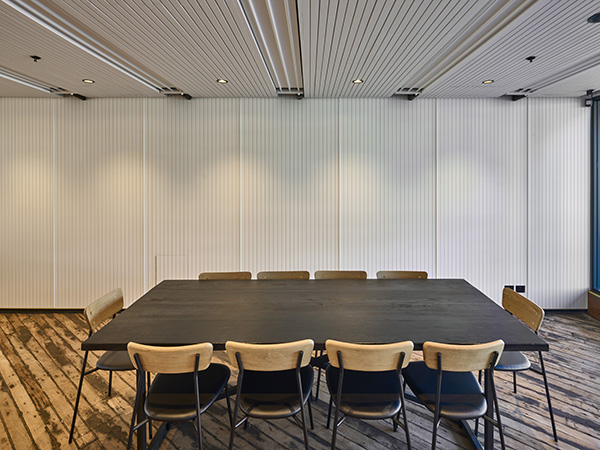When it comes to interior walls and ceilings, there are a few things that all hospitality spaces have in common. Whether the setting in question is a café, a restaurant, a music venue, or a hotel, all require surfaces of this type that are non-stain, non-scruff, non-flammable, and acoustically sound.
Increasingly, in addition to the above list of requirements, we can add the recurring demand amongst specifiers for wall and ceiling materials that are not just recyclable but produced with carbon abatement in mind.
In response leading players like Deco Australia, a manufacturer of aluminium architectural building systems and finishes, have moved their operations in more environmentally friendly directions.
Specifically, the company has partnered with Capral Aluminium to supply a product called Local Green lower-carbon aluminium. Deco is leading the way by being the first to commit to switching all their Capral aluminium extrusions to the more environmentally friendly material.
Explaining the move, Richard Hamber, General Manager Deco Australia says: “The switch to Local green aluminium will also directly support our customers across the architectural and building industries by supplying aluminium building products made from responsibly sourced, lower-carbon aluminium, helping them to achieve their own sustainable initiatives and outcomes.”
The company’s latest products, which are suitable for hospitality applications include a new QuickClick batten, within the DecoBatten range, which has a slimline profile and is suitable for interior walls and ceilings; DecoPanel, which is suitable for a wide range of applications, including wall panels and linings, cladding, architectural screening, wet area lining, and even acoustic paneling; and DecoSplash, which is a practical and visually appealing wall lining solution.

Image: Decosplash from Deco Australia / Supplied
The stone cladding trend
In another development, stone cladding products, including those available from Haus Collective, are becoming popular.
While increased global supply has seen international players extend their market into places like Australia based on demand in the residential building sector, the materials are also finding use in hospitality applications.

Haus Collective Travertine Stone Cladding / Supplied
With the increased incorporation of elements such as render and natural timber screens in restaurants, bars and so forth, there has been a subsequent need to break these elements up. In these cases, natural stone cladding, with its inherent warmth and depth, has proven a viable solution.
Ensuring the design aesthetic and the appearance of solid stonework, but without the high cost, cladding of this type can be installed on light weight construction materials, both on the inside and outside of hospitality projects.

Image: Haus Collective
Filling market gaps
Elsewhere, products like the Silhouette range of decorative wall panelling by Easycraft fill an obvious gap in the market. An intricate, detailed product that is suitable for a range of applications, including within hospitality settings, it provides depth and texture wherever it is installed.
Cost effective and easy to work with, the range aims to inspire ‘material lead’ design, providing designers with the ability to incorporate natural shapes and shadows through hard-wearing durable materials. As used at Alba Cooking School, a project by H&G Designs and Studio Shibui, the Silhouette range is available in three styles – Convex, Cove, and Channel.
Featuring a free-flowing form punctuated by subtle uniformity, Convex has a tactile nature that plays with light to produce organic shapes and shadows. Meanwhile Cove, which was inspired by the Australian coastline, combines undulating curves with dramatic ridge lines; and Channel features strongly defined channels spaced between unassuming plateaus.
Acoustics
As ever, acoustic considerations are important in hospitality environments of all types. According to Atkar Group, when considering architectural and acoustic panelling systems it is becoming increasingly important to focus on solutions rather than a copy and paste process.
As Nate Ward, National Marketing Manager Atkar Group, points out, local production, environmental/fire/acoustic accreditation, unique designs rather than off-the-shelf products, are more popular than ever.
“Having internal expertise in fire ratings and being able to recommend whole-project fire rating solutions has been a great asset to our customers to date,” he says. “Our clientele expects an end-to-end solution and have no room for technical errors that are so prevalent in the design industry.”
Atkar offers a broad range of architectural acoustic solutions, including Au.diMicro, which is an attractive, real timber veneer designed to minimise the ‘Swiss cheese’ appearance of some perforated panels; and Vogl, a monolithic acoustic ceiling option, which features a unique installation system that negates the common issue of cracking caused by using compounds and fillers.
According to Ward, the importance of overall acoustic expertise should never be underestimated.
“Designers and architects come to us with different levels of formed ideas, and Atkar’s combination of experience, design, building expertise and technical knowledge greatly assists them in developing their projects. We pride ourselves and take delight in partnering with our clients, rather than just selling a product,” he says.
Material innovation
Within hospitality applications, there has been a notable surge in the utilisation of robust materials like aluminium and fibre cement, complemented by innovative finishes such as woodgrain foils and printing techniques that emulate the appearance of natural timber. Not only does this material genuinely resemble timber, but it also surpasses expectations in terms of non-combustibility and moisture resistance, qualities that hold real significance in hospitality establishments.
In line with this trend, DecorSlat AliSorb, the newest addition to the Slat range by Décor Systems, stands out for its durability and non-combustible properties, making it safe for busy hospitality venues. Moreover, its acoustic lining has excellent sound absorption capabilities, making it an ideal solution for optimising the acoustic environment.
Likewise, the supplier’s DecorLux product, made of perforated fibre cement, has a new finish available. The captivating print finish strikingly emulates the appearance of genuine timber veneer.
The advancements in printing technology have enabled a seamless integration of aesthetics and performance, allowing both aspects to flourish in perfect harmony.

Sydney Theatre Company by Decor Systems
Homely experiences
According to Woven Image, a leader in sustainable acoustic finishes, the growth in novelty and unique artistic expressions is increasing, along with spaces that provide a homely experience. Venues are using unique surfaces and colour to support such design ambitions.
Designs like Echopanel Longitude provide a shadow line that can mimic wood panelling, while the company’s Echopanel Palace references art deco through smooth curvature.
As seen in the Bathers Pavilion, Echopanel Longitude in navy, was able to complete the nautical look while dampening sound reverberation, providing acoustic comfort in a busy space. Similarly, in The Growers, Echopanel Longitude provided an elegant and subtle ceiling feature, matching surrounding colours. Its straight lines provided depth to an otherwise bland and noisy ceiling.
Italian restaurant Lombra, on the other hand, used Woven Image’s in-house baffle design Viaduct to present their customers with a ceiling feature reminiscent of Roman architecture. In this case, the baffles helped to reduce sound reverberation while increasing speech intelligibility in the space, making visiting the restaurant a more enjoyable experience for customers.
Acoustic retrofitting
Often the need to rectify the acoustics in hospitality spaces only becomes apparent once a business is operational. Frequently this comes about because of patron complaints. Although it is possible to apply acoustic treatments in such cases, it can be costly.
“There are some interesting ideas put forward to negate these costs – such as sticking acoustic panels underneath dining tables which serves only as a hygiene hazard and is not effective in reducing noise reverberation,” says Rob Jones, Technical & Development Manager at Autex Acoustics.
“Alternatively, applying panels to the ceiling, which, aside from detracting from the space's aesthetic, also requires adhesives with odours that can take weeks to dissipate.”
According to Jones, therefore adhesive-free acoustic systems that don’t require several specialist tradespeople and add to the space's aesthetic are ideal for hospitality settings.
“Clip-on panels that can be fitted quickly and lightweight suspended acoustic baffles and clouds are becoming go-to solutions. They can be fitted after hours with minimal disruption to business operations,” he explains.
Design & colour choice
Products within CSR Martini’s Deco Collection represent some of the latest innovations in the acoustic market. Available in Australia from Himmel Interior Systems, products in the range include a patented suspended acoustic blade system that offers high performance acoustics but also has the capacity to reduce Installation time by up to 20 percent.
The collection also includes a high performing range of 3D wall tiles. Available in five designs and 22 colour options, the tiles provide the flexibility of design freedom to change the designs whenever necessary.
To support these products, Himmel Interiors Systems, in association with Acoustic Directions, have created an RT Calculator, which is intended to assist those who, while they cannot afford the services of acoustic engineers, need to understand ways to improve acoustics.
Acoustic performance meets air purification
Elsewhere, products like Creason and Createx, which are available from Siniat, have the extra benefit of having air-purifying qualities. As such, they are ideal for hospitality environments in which there is a lot of coming and going, and therefore the potential for poor air quality.
According to the distributor, the acoustic performance of Creason and Createx is achieved through a combination of sound diffusion (whereby reflected sound energy is spread out) and sound absorption (whereby sound energy is removed as it travels through the perforation holes and acoustic fleece backing).
As installed at Sydney’s famous Bondi Pavilion, Createx is manufactured with high quality, ultra-sharp perforations in a variety of continuous perforated patterns for a seamless finish.
Meanwhile, Creason comes in two perforation patterns and is ideal for use in a range of internal applications where controlling the sound reverberation time is required. In addition, it can also be used at the top of internal walls (above traffic areas) where control of sound absorption and reverberation time is required.
Seamless acoustic ceiling
The final word goes to Ecko Solutions, whose seamless acoustic ceiling was used to great effect by Cera Stribley Architects at St Hubert’s Winery.
When guests step into a setting such as this, their expectations extend beyond just the visual appeal. They anticipate a sensory journey that engages their ears as much as their eyes. Ecko Solutions Seamless acoustic ceiling provided the means to curate this auditory experience, ensuring that the soundscape remains harmonious and pleasurable.
In this case, the architects worked in partnership with the Ecko Solutions team to create a unique custom concrete look finish throughout the dome shaped ceilings.
Unlike conventional visible treatments like acoustic panels or baffles, seamless acoustic treatments blend seamlessly into the interior design. In this way, by integrating acoustic solutions discreetly, the architects had the freedom to prioritize aesthetics without compromising on acoustic performance. This unobtrusive elegance that resulted allows the space to maintain its visual charm while delivering exceptional sound quality.
Image: Autex Acoustics / Supplied
Suppliers
Atkar Group
Autex Acoustics
Decor Systems
Haus Collective
Deco Australia
Ecko Solutions
Woven Image
Easycraft
Himmel Interior Systems
Siniat

